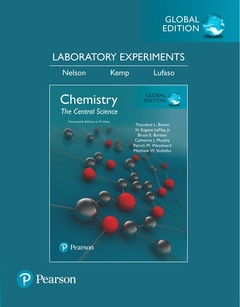Laboratory Experiments for Chemistry: The Central Science in SI Units, Global Edition (14th Ed.)
Auteurs : Brown Theodore, LeMay H., Bursten Bruce, Murphy Catherine, Woodward Patrick, Stoltzfus Matthew

Prepared by John H. Nelson and Kenneth C. Kemp, both of the University of Nevada, this manual contains 43 finely tuned experiments chosen to introduce students to basic lab techniques and to illustrate core chemical principles. In the 14th Edition, all experiments were carefully edited for accuracy, safety, and cost. Pre-labs and questions were revised and new experiments added concerning solutions, polymers, and hydrates.
Each of the experiments is self-contained, with sufficient background material, enabling students to conduct and understand the experiment. Each has a pedagogical objective to exemplify one or more specific principles. Because the experiments are self-contained, they may be undertaken in any order, although the authors have found in their General Chemistry course that the sequence of Experiments 1 through 7 provides the firmest background and introduction. To assist the student, the authors have included pre-lab questions for the student to answer before starting the lab. The questions are designed to help the student understand the experiment, to learn how to do the necessary calculations to treat their data, and as an incentive to read the experiment in advance.
- 1. Introduction: Matter, Energy, and Measurement
- 2. Atoms, Molecules, and Ions
- 3. Chemical Reactions and Reaction Stoichiometry
- 4. Reactions in Aqueous Solution
- 5. Thermochemistry
- 6. Electronic Structure of Atoms
- 7. Periodic Properties of the Elements
- 8. Basic Concepts of Chemical Bonding
- 9. Molecular Geometry and Bonding Theories
- 10. Gases
- 11. Liquids and Intermolecular Forces
- 12. Solids and Modern Materials
- 13. Properties of Solutions
- 14. Chemical Kinetics
- 15. Chemical Equilibrium
- 16. Acid—Base Equilibria
- 17. Additional Aspects of Aqueous Equilibria
- 18. Chemistry of the Environment
- 19. Chemical Thermodynamics
- 20. Electrochemistry
- 21. Nuclear Chemistry
- 22. Chemistry of the Nonmetals
- 23. Transition Metals and Coordination Chemistry
- 24. The Chemistry of Life: Organic and Biological Chemistry
- Appendices
- Mathematical Operations
- Properties of Water
- Thermodynamic Quantities for Selected Substances
- Aqueous Equilibrium Constants
- Standard Reduction Potentials
- Answers to Selected Exercises
- Answers to Give It Some Thought
- Answers to Go Figure
- Answer to Selected Practice Exercises
- Glossary
THEODORE L. BROWN received his Ph.D. from Michigan State University in 1956. Since then, he has been a member of the faculty of the University of Illinois, Urbana-Champaign, where he is now Professor of Chemistry, Emeritus. He served as Vice Chancellor for Research, and Dean of The Graduate College, from 1980 to 1986, and as Founding Director of the Arnold and Mabel Beckman Institute for Advanced Science and Technology from 1987 to 1993. Professor Brown has been an Alfred P. Sloan Foundation Research Fellow and has been awarded a Guggenheim Fellowship. In 1972 he was awarded the American Chemical Society Award for Research in Inorganic Chemistry and received the American Chemical Society Award for Distinguished Service in the Advancement of Inorganic Chemistry in 1993. He has been elected a Fellow of the American Association for the Advancement of Science, the American Academy of Arts and Sciences, and the American Chemical Society.
H. EUGENE LEMAY, JR., received his B.S. degree in Chemistry from Pacific Lutheran University (Washington) and his Ph.D. in Chemistry in 1966 from the University of Illinois, Urbana-Champaign. He then joined the faculty of the University of Nevada, Reno, where he is currently Professor of Chemistry, Emeritus. He has enjoyed Visiting Professorships at the University of North Carolina at Chapel Hill, at the University College of Wales in Great Britain, and at the University of California, Los Angeles. Professor LeMay is a popular and effective teacher, who has taught thousands of students during more than 40 years of university teaching. Known for the clarity of his lectures and his sense of humor, he has received several teaching awards, including the University Distinguished Teacher of the Year Award (1991) and the first Regents’ Teaching Award given by the State of Nevada Board of Regents (1997).
BRUCE E. BURSTEN received his Ph.D. in Chemistry from the University of Wisc
This title is a Pearson Global Edition. The Editorial team at Pearson has worked closely with educators around the world to include content which is especially relevant to students outside the United States.
Chemistry: The Central Science, 14th Edition uses relevant content to engage students throughout the learning process, building skills that allow them to go beyond recall to effectively solve problems and visualize the atomic nature of the chemistry.
- Beyond Knowledge Recall:
- NEW! SmartFigures walk students through complex visual representations, dispelling common misconceptions before they can take root by animating them into a continuous process rather than being forced to rely on discrete time points. Students are given answer-specific video feedback from the author team that validates their correct response or helps them get back on track by understanding why they were wrong, often revisiting the animation in a way designed to aid them in overcoming their misconception.
- Integrative Exercises connect concepts in the current chapter with those from previous chapters and serve as an overall review of key concepts, helping students gain a deeper understanding of how chemistry fits together. Sample Integrative Exercises in many chapters show how to analyze and solve problems encompassing more than one concept.
- Design An Experiment activities provide a departure from the usual end-of-chapter exercises with an inquiry-based, open-ended approach that stimulates a student to “think like a scientist.” Designed to foster critical thinking, each exercise presents the student with a scenario in which various unknowns require investigation. The student is called upon to ponder how experiments might be set up to provide answers to particular questions about observations.
- Informal, sharply focused Give It Some Thought (GIST
Date de parution : 07-2018
Ouvrage de 752 p.
21.5x27.5 cm


